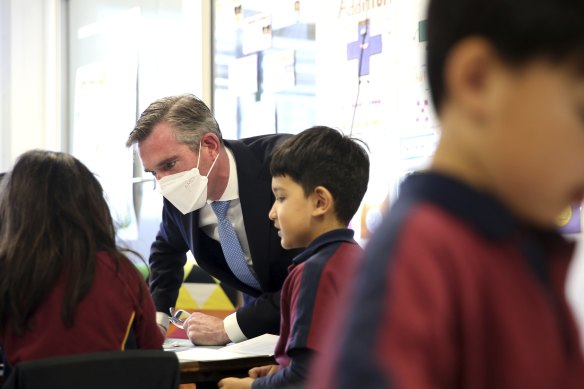This was published 3 years ago
Opinion
Crisis in education a test for Perrottet government
Geoff Gallop
Former premier of Western AustraliaIt’s never easy for governments to address long-term or structural challenges when prioritising budget bids and legislative proposals. The power of immediate interests and the political forces they generate can never be underestimated, as we are seeing with climate policy and as we saw in earlier times with land clearing. As hard as these bigger issues are, avoiding them comes at significant cost down the track
Indeed, one of the arts of government is knowing when progress demands the bar be raised.

Premier Perrottet visits a NSW school. The state’s public schools are facing teacher shortages. Credit: SMH
We have markets, of course, that are said by many to be best equipped to sort these things out through price signals and what the Prime Minister has defined as ″can-do capitalism″. More often than not, for those who think this way, market failure is the fault of government intervention rather than a structural fault needing to be repaired by public policy.
The labour market is a particularly awkward beast, but vital to employees and their families aspiring to a dignified life and also to the economy as a whole. It’s that all-important mix of intellectual and mental capital needed for a good economy and society.
Can-do capitalists are pretty hopeless without it and without the progressive governments that can facilitate it with properly supported health, education and community service systems. These are foundational in ways we have come to appreciate during the pandemic or whenever there is fire or flood.
Yet note the mixed signals sent to our young. The Australian Financial Review reports: ″Companies are offering 20 per cent-plus pay rises to snap up investment bankers, lawyers, marketing executives, accountants, construction managers and sustainability and risk specialists amid a professional skills shortage that is spreading far beyond the IT sector.″
Here we see the private sector doing what it must to lure the workforce it needs. Too bad if some of those smart young people might have aspired to be teachers. NSW is confronting a serious shortage of teachers and yet, if we put the words ″public″ and ″teacher″ into the mix, out the door goes the much-vaunted level playing field.
The NSW government insists it can offer no more than a 2.5per cent pay rise to public school teachers. It rejects the teachers’ claim of 5 to 7.5 per cent – plus two extra hours a week for lesson planning and collaboration – a claim that is backed up by the independent inquiry I chaired on behalf of the NSW Teachers Federation.
Our report, Valuing the Teaching Profession, was further backed by Grattan Institute research that found teacher salaries and career paths were inadequate and uncompetitive. It reported Australia’s top teacher salary was 40 per cent higher than the starting salary as compared with the OECD average of 80 per cent.
It seems the market is a good guide for some, but not others. In the case of teaching, the consequences are diabolical. We now know that Department of Education advice to the state government confirms what my inquiry also concluded: NSW faces ″a large and growing shortage″ of teachers.
As a result, staff are teaching ″out of field″ – that is history teachers teach maths, or social science teachers teach English. Out-of-field teaching now accounts for 15 per cent of all teachers. The department reports the problem is particularly severe in ″rural and regional areas, secondary and where there has been significant population growth″.
Add to this the ageing of the workforce: 28 per cent of teachers and 45 per cent of principals will reach retirement age by 2024.
In Valuing the Teaching Profession, we identified not just remuneration but profound changes in the work and workloads of teachers as important when it comes to recruiting. Teachers must deal with constant policy changes, significant increases in student needs, rapid changes in technology, expansion of and changes to curriculum, and new compliance, administration, data collection and reporting responsibilities. Change is relentless and often ill-prepared.
Add to that a devolution policy that destroyed a range of school and teacher supports which had served the system well. As former director-general of NSW education Ken Boston put it in relation to the mission of public schools to tackle disadvantage: “School autonomy is an irrelevant distraction.” What’s needed, he says, is “immediate diagnosis of learning needs and immediate and intensive personalised teaching”.
NSW is at a crossroads, its public school system threatened by ill-considered policies and a rigid approach to wages. As my inquiry concluded: ″Taken with the fragile and inadequate staffing mechanisms currently in place, the salary levels in place and projected for the next three to five years are dangerous for the public standing of the profession, and for the quality of education available to the students of the state’s public schools.″
A crisis it is and a real test for the NSW government and Parliament.
The Opinion newsletter is a weekly wrap of views that will challenge, champion and inform your own. Sign up here.